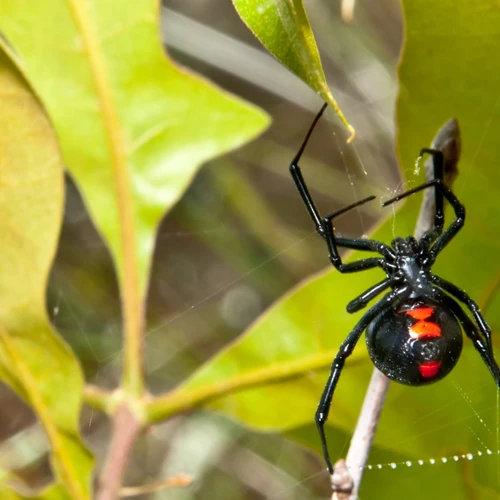As fascinating creatures that have garnered fear and curiosity among humans for generations, black widow spiders remain one of the most enigmatic species in the animal kingdom. From their distinctive red hourglass markings to their web-building prowess, these spiders have adapted to a wide range of habitats and climates. However, one of the most critical factors that affect their survival and well-being is humidity in their habitat. Understanding the significance of humidity in black widow spiders’ habitat selection is essential to their conservation and our understanding of their behavior. Let’s delve deeper into this topic and explore the crucial role of humidity in the lives of these fascinating creatures.
Black Widow Spiders’ Habitat and Behaviors
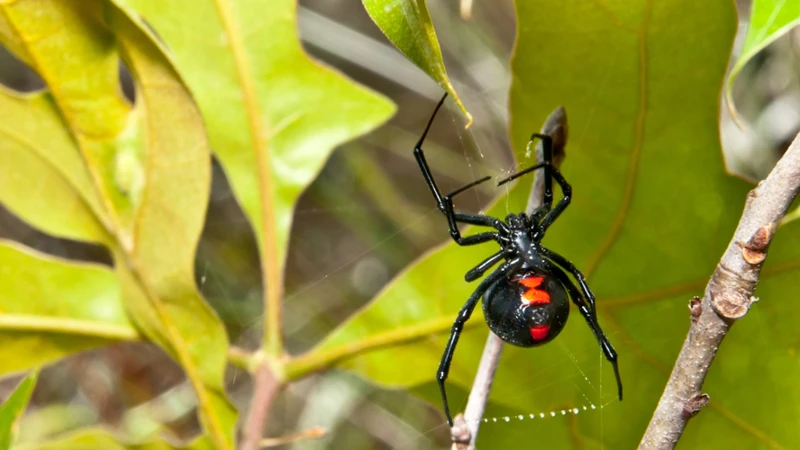
Black Widow Spiders are infamous for their venomous bites and the female’s distinctive red hourglass-shaped marking. But did you know that their habitat selection plays a vital role in their behavior and reproductive success? Understanding the habitat and behaviors of Black Widow Spiders is crucial for their conservation and management. Various factors such as structural complexity, abiotic factors, and ecological niche affect their habitat selection. In the following sections, we will explore the habitat requirements, hunting behaviors and reproduction of Black Widow Spiders, and how humidity affects them. We will also discuss the factors that affect humidity in their habitat, and how human activities can impact these factors. Finally, we will discuss strategies for the conservation of Black Widow Spiders’ habitat and management of their populations.
Habitat Requirements
Habitat Requirements
Black widow spiders are found in a variety of habitats across the world. They are commonly found in warm and dry climates, which include deserts and arid grasslands. These spiders are also adapted to living in human-made environments such as homes, buildings, and other structures. However, the conditions required for black widow spider habitats vary depending on factors such as temperature, humidity, vegetation, and prey availability.
The table below summarises the main habitat requirements of black widow spiders:
| Requirement | Description |
|---|---|
| Temperature | Black widow spiders require a warm environment to thrive. They prefer temperatures of 70 to 84°F (21-29°C), with females exhibiting a narrower temperature range than males. |
| Humidity | While black widow spiders require some degree of moisture in their habitat, excessive humidity can be detrimental to their survival. They thrive in moderately arid environments, with a higher preference for low humidity. |
| Vegetation | The spider is often found in areas of structural complexity, such as leaf litter and debris piles, which can provide shade and a humid microclimate. Black widows also tend to hide in vegetation such as bushes and tall grass. |
| Prey availability | Black widow spiders feed primarily on insects, and their habitat must provide an adequate food supply. They are often found in areas with a high concentration of insects like flies, mosquitoes, and grasshoppers. |
Understanding black widow spider’s habitat requirements is important in creating suitable habitat for them, ensuring their existence and conservation. Factors such as climate, soil, vegetation, and human activities all play a role in creating the ideal habitat for these spiders. To learn more about the effects of climate change on black widow spiders, visit climate change and black widow spider habitats.
Hunting Behaviors and Reproduction
Black widow spiders have unique hunting behaviors and reproductive habits that are worth discussing. Female black widows are known for their cannibalistic tendencies, where they often consume their male partners after mating. This well-known behavior is sometimes exaggerated in popular culture, as it does not always occur in every case and is believed to have an adaptive benefit.
Female black widow spiders also lay their eggs in silk sacs, which they protect and defend aggressively. Upon hatching, the spiderlings will remain in the sac for a brief period before venturing out on their own. To hunt, black widow spiders weave webs that are strong enough to capture prey. They use their venomous bite to subdue their prey and then wrap it in silk before consuming it.
It is important to note that the hunting behaviors and reproductive habits of black widow spiders are influenced by their habitat and environment. For example, black widow spiders living in urban areas may have different behaviors than those living in rural areas. This could be due to differences in food availability or competition with other predators. Understanding these behaviors in relation to their habitat can help researchers further comprehend the ecological niche of black widow spiders and the factors that influence their survival.
If you want to learn more about the structural complexity of black widow spiders, you can read our article: “Structural Complexity of Black Widow Spiders”.
Humidity and Black Widow Spiders
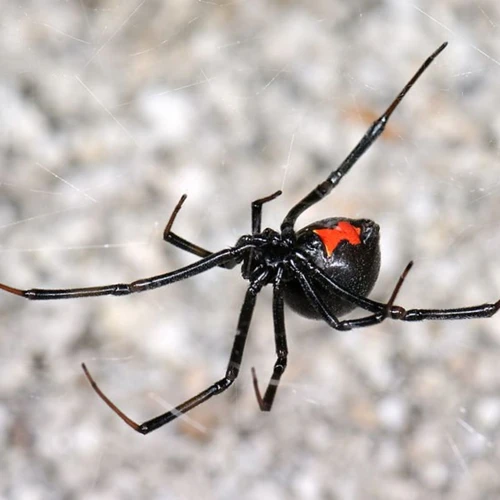
Black widow spiders are fascinating creatures, and understanding their habitat and behavior is crucial for their conservation. One of the abiotic factors that greatly affects black widow spiders is humidity. Humidity plays a vital role in the survival and well-being of black widow spiders, and in this section, we will explore the correlation between humidity and black widow spiders. We will also discuss the humidity preferences of black widow spiders and how it affects their ecological niche. To learn more about the ecological niche of black widow spiders or other abiotic factors affecting their habitat, please refer to our previous articles “Ecological Niche of Black Widow Spiders” and “Abiotic Factors that Affect Black Widow Habitat”.
How Humidity Affects Black Widow Spiders
Humidity plays a crucial role in the survival of black widow spiders. These spiders require a specific level of humidity in their habitat to thrive. If the humidity level goes beyond or below their preferred range, it can directly affect the spiders in various ways.
When humidity is too high, black widow spiders may experience difficulties in hunting. High humidity levels can cause the spider’s web to become damp and sticky, making the silk stick together, and making it hard for the spider to detect and capture prey. The humidity can also create an unfavorable condition for the spiders as too much moisture encourages the growth of fungi and bacteria that may become harmful to them.
On the other hand, when humidity is too low, the spider’s silk dries up, thereby making it weak and brittle. This can make it difficult for the spider to build and maintain its web, which is central to its survival as it is used to capture prey. Additionally, low humidity can cause the spider to lose moisture through its exoskeleton, making them more susceptible to dehydration.
It is crucial to maintain the ideal humidity level in the black widow spider’s habitat for them to thrive. The table below summarizes the key impacts of humidity on black widow spiders.
| Humidity Level | Impact on Black Widow Spiders |
|---|---|
| Too High | Difficulty in hunting, damp spider’s web, growth of harmful fungi and bacteria. |
| Too Low | Weak and brittle spider’s silk, difficulty in building and maintaining webs, increased risk of dehydration. |
Understanding the impact of humidity levels on black widow spiders’ habitat is essential in developing strategies to better conserve and protect their natural habitat. To learn more about the effects of urbanization on black widow spider habitats, read our article on urban-rural black widows habitats.
Humidity Preferences of Black Widow Spiders
Black Widow spiders’ preference for humidity is vital for understanding their habitat requirements. Black Widows prefer warm, dark, and humid environments that allow them to survive and thrive. They are most commonly found in areas with a humidity level of 50-80%, which is higher than the average humidity level found in many regions. This preference for high humidity is particularly important because it helps regulate spider’s breathing, water balance, and metabolic functions.
According to research, Black Widow spiders are active and highly susceptible to water loss when humidity levels fall below 40%. When the humidity levels are too low, the spiders may face desiccation and may not survive. High humidity levels are also necessary for the survival of Black Widow spider’s prey, such as crickets and other insects. These insects also require humid environments to survive, which makes Black Widow’s preference for humid habitats an evolved adaptation suited to their hunting success.
In addition to their preference for high humidity, Black Widow spiders are also highly selective in choosing their habitats. They tend to be found in areas with high moisture-retaining soils, such as clay soils or areas with sufficient moisture levels near or beneath rocks. Such areas usually have a broad range of hiding places and provide stable climatic conditions for the spiders. An html table to show the humidity preferences of Black Widow spiders:
| Humidity Levels (%) | Behavioral Response of Black Widow Spiders |
|---|---|
| Below 40% | Spider’s activity and movement are reduced |
| 40%-50% | Spiders may move to areas with higher humidity levels |
| 50%-80% | Humidity levels preferred by Black Widows for survival |
| Above 80% | May cause mold growth and rot, which can drive away spider’s prey insects |
It is important to know the moisture and humidity levels while identifying the habitat suitability index for Black Widow spiders. Those who want to attract Black Widow spiders to their garden should keep these humidity preferences in mind while designing and maintaining their garden’s habitat. Similarly, evaluating soil factors and the black widow spider’s habitat can help us understand the moisture levels required for a sustainable Black Widow spider habitat. Being aware of humidity and temperature is also useful while exploring different ways of attracting Black Widow spiders.
These adaptations and preferences of Black Widow spiders are important to factor in conservation efforts. It is necessary to conserve and restore habitats that provide suitable conditions for Black Widow spiders, including humidity levels. Proper conservation practices, such as protection of natural habitats, restoration of degraded habitats, and community outreach and education may help in the long-term survival of these fascinating and important species.
Factors that Affect Humidity in Black Widow Spiders’ Habitat
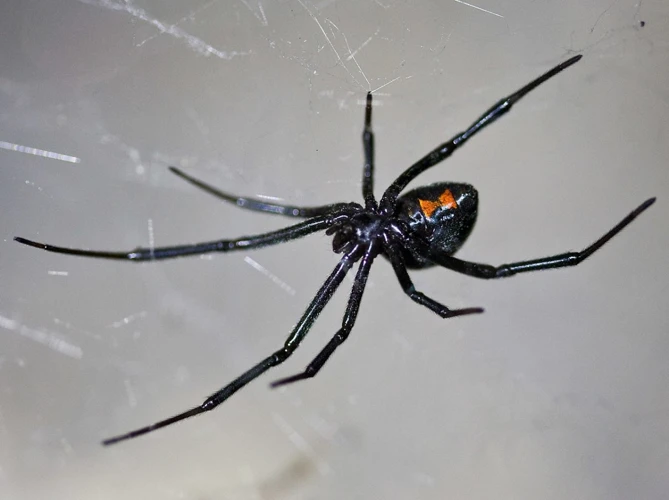
Humidity is a crucial factor in the habitat of black widow spiders, affecting their behavior, reproduction, and physiological functions. Understanding the factors that influence humidity in their environment is essential for predicting their occurrence and distribution. Several factors impact the humidity levels in the habitat of black widow spiders, such as climate, geography, vegetation, soil, and water sources. These factors can directly or indirectly impact the humidity levels, making it important to evaluate their effect on black widow spiders’ habitat. In this section, we delve deeper into these factors and their impact on the habitat of black widow spiders.
Climate and Geography
Strong climate patterns and geographical factors play a significant role in determining the level of humidity in black widow spiders’ habitats. Regions with high precipitation rates and humidity levels, such as coastal areas, are likely to have higher humidity levels compared to arid regions. For instance, the southeastern regions of the United States are the natural habitats for black widow spiders due to their humid climate.
Temperature and precipitation levels also affect the amount of humidity in black widow spider habitats. If the temperature is too high, it may increase the rate of evaporation, leading to lower humidity levels. This can be detrimental to the survival of black widow spiders, as they prefer moderate to high humidity. On the other hand, areas with low precipitation rates, such as deserts, may have low humidity levels, which are also unfavorable for black widow spiders.
The proximity of black widow spider habitats to water sources can have a significant impact on humidity levels. Areas close to lakes, rivers, and streams are more likely to have higher humidity levels than areas that are far from water sources. Additionally, the type of vegetation and soil also influences the humidity levels in black widow spider habitats. Forested areas are likely to have higher humidity levels compared to open grasslands due to the amount of shade and moisture retention from the soil.
According to a study on evaluating soil factors and black widow spider habitats, sandy soils may have lower humidity levels compared to clay soils. This is because clay soils have a higher capacity to retain moisture compared to sandy soils. Areas with clay soils may have higher humidity levels, which are more conducive to black widow spiders’ survival.
Understanding how climate and geography impact humidity levels in black widow spider habitats can be beneficial in determining their habitat suitability. The Black Widow Habitat Suitability Index is a helpful tool that evaluates different environmental factors, including climate and geography, to identify suitable habitats for black widow spiders. It can be used to attract black widow spiders to an area or help eradicate them from a specific location.
Ultimately, conserving black widow spider habitats requires a multifaceted approach that includes protecting and restoring natural habitats, considering human activities that impact humidity levels, and educating communities on the importance of supporting black widow spider populations in their natural habitats.
Vegetation, Soil, and Water Sources
Vegetation, Soil, and Water Sources: The presence of vegetation, soil and water sources are important factors in determining humidity levels in black widow spider habitats. Dense vegetation provides shade and traps moisture, making the surrounding air more humid. The soil type is also an important determinant of humidity levels as it can retain moisture and influence drainage. Black widow spiders are commonly found in areas where there is rocky soil, as the soil can retain more moisture and provide better drainage.
The availability of water sources is crucial for maintaining humidity levels in black widow spider habitats as spiders need to drink water to survive. Streams, rivers, lakes, and wetlands are ideal water sources that can maintain a high level of humidity. In areas where natural water sources are limited, black widow spiders may be found in man-made water sources such as fountains, bird baths, and even swimming pools.
It’s important to note that changes in vegetation, soil, and water sources can have negative impacts on black widow spider habitats. Deforestation, soil erosion, and construction activities can reduce moisture retention capacity and alter the habitat’s humidity levels, making it unsuitable for black widow spiders. It’s crucial to evaluate soil factors and moisture levels to maintain suitable habitats for black widow spiders. You can read more about evaluating soil factors and black widow spider habitats by following this link.
To attract black widow spiders, it’s essential to maintain their preferred habitat conditions. You can create favorable humidity levels by planting vegetation and providing water sources such as water fountains or bird baths. However, it’s essential to be cautious when approaching black widow spiders and avoid disturbing their habitat. You can read more about attracting black widow spiders by following this link.
Different types of vegetation can also affect the microclimate of black widow spider habitats. For example, deciduous forests that drop their leaves in autumn can significantly impact humidity levels. With leaf litter and decomposition, the surrounding soil retains both heat and moisture, providing a comfortable habitat for black widow spiders. For more information about black widow spider habitats, check out our guide on black widow habitats.
Temperature and humidity levels play a crucial role in determining the suitability of habitats for black widow spiders. Black widow spiders thrive at a specific combination of humidity and temperature levels. You can learn more about the relation between temperature and black widow spider habitat by following this link.
Human Activities that Affect Humidity and Black Widow Spiders’ Habitat
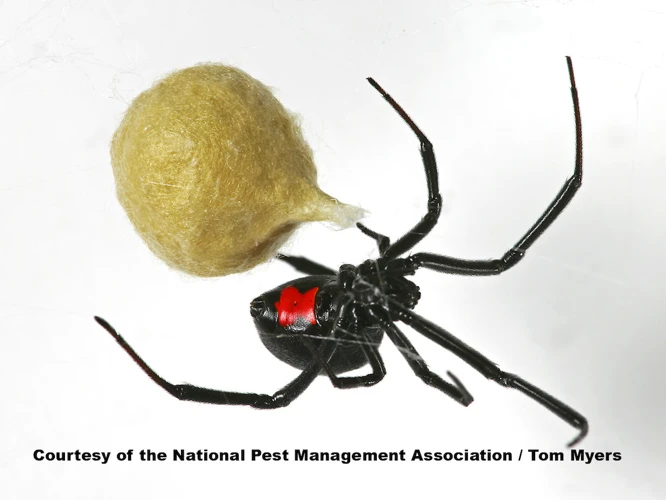
As human population growth and urbanization continue to expand, the natural habitats of black widow spiders are under threat. Human activities greatly affect humidity, vegetation, and temperature, altering the microclimate of black widow spider habitats. These changes can lead to habitat loss, fragmentation, and degradation, affecting the suitability of their habitats. To find out how human activities and changes in the environment affect the habitat suitability index of black widow spiders, read on.
Deforestation and Land Use Changes
Deforestation and land use changes have a significant impact on the humidity levels of black widow spider habitats. The removal of forests and other vegetation reduces the amount of shade, which in turn increases exposure to sunlight. This can cause the soil to dry out more quickly and reduce humidity levels. Deforestation and other land use changes can alter the landscape and change the hydrological characteristics of the area, which can further impact humidity levels.
Deforestation is the process of clearing or thinning forests and woodlands, often to make way for agriculture, urbanization, or infrastructure development. Deforestation can lead to the destruction of habitats for various species, including black widow spiders. According to a study published in the Journal of Insect Science, deforestation can exacerbate the impact of droughts on spider populations in semi-arid regions. In turn, this can affect local insect populations, which are a primary source of food for black widows.
Land use changes, which refer to alterations in the way land is used, can also negatively impact black widow habitats. For example, the conversion of natural habitats to agricultural land can lead to changes in soil quality and reduce the amount of shade and vegetation in an area. Additionally, urbanization can lead to the replacement of natural habitats with built environments that have fewer natural humidity-regulating features. This can have a profound effect on the health of black widow populations.
To ensure that black widow habitats remain viable, it is important to monitor land use changes and ensure that responsible land practices are in place. Conservation programs that promote sustainable forestry practices, such as selective logging, can help maintain natural habitats while providing economic opportunities for local communities. Additionally, implementing policies that prioritize the protection of natural habitats can help ensure that black widow spiders have the resources necessary to thrive.
To assess black widow habitat suitability in a particular area, researchers use a tool called the Black Widow Habitat Suitability Index. This tool takes into account factors such as humidity levels, vegetation cover, and prey availability to determine the potential suitability of an area as a black widow habitat. By using this tool, conservationists and policymakers can make informed decisions about land use and protect critical habitats for black widow spiders.
Urbanization and Climate Change
The increasing rate of urbanization and climate change is posing a major threat to the survival of black widow spiders. Urbanization alters the natural habitat of these spiders by reducing vegetation cover, which is necessary for regulating humidity levels. Cities have a higher concentration of impervious surfaces such as roads and buildings. These surfaces prevent rainwater from seeping into the ground, reducing the overall moisture levels in the surrounding environment.
Table 1: Negative impacts of urbanization and climate change on humidity and black widow spiders’ habitat.
| Negative Impact | Description |
|---|---|
| Reduced vegetation cover | Urbanization leads to the destruction of natural vegetation cover, which serves as an important regulator of humidity levels. |
| Less infiltration of water | Urbanization leads to an increase in impervious surfaces such as roads, which reduce water infiltration into the soil, lowering the overall moisture levels. |
| Increased air pollution | Urban areas are known to have higher levels of air pollution which may disrupt the respiratory system of black widow spiders, which is highly sensitive to changes in the environment. |
| Rising temperatures | Climate change is contributing to an increase in global temperatures. This increase in temperatures can lead to the drying out of the soil and the surrounding environment making it unsuitable for the survival and reproduction of black widow spiders. |
| Changes in precipitation patterns | Climate change is causing changes in precipitation patterns. Areas that used to have a high rainfall may now experience drought which can negatively affect the black widow spider’s habitat selection and survival. |
Climate change, on the other hand, is causing an increase in the overall temperature levels, which can lead to the drying out of the soil and surrounding environment. This can make the area unsuitable for the survival and reproduction of black widow spiders. Climate change is also causing changes in precipitation patterns, with areas that used to have high rainfall now experiencing droughts.
Urbanization and climate change are major threats to the survival and conservation of black widow spiders. It is important for individuals and communities to take steps to reduce the impact of these threats by incorporating measures such as sustainable city planning, habitat restoration, and community outreach and education. Without such efforts, the future of black widow spiders could be in peril, leading to ecosystem imbalances and potential public health concerns.
Conservation of Black Widow Spiders’ Habitat
As with any species, the conservation of black widow spiders’ habitat is crucial for their survival. Without the proper habitat conditions, black widow spiders may struggle to find food, water, and shelter, leading to population decline. Taking steps to protect and preserve their habitat can help ensure these fascinating creatures continue to thrive. In this section, we will explore different conservation methods that can be implemented to support black widow spiders’ habitat.
Protection of Natural Habitats
The protection of natural habitats is a crucial step in conserving black widow spiders and their preferred environments. One effective method of preserving these habitats is the establishment of protected areas, such as national parks or wildlife reserves. These areas provide a safe haven for black widow spiders and other wildlife, ensuring that their habitats are not disturbed by human activities.
Table: Examples of Protected Areas for Black Widow Spiders
| Protected Area | Location | Reasons for Protection |
|---|---|---|
| Black Widow Canyon Natural Reserve | Arizona, USA | Home to the largest population of black widow spiders in the region |
| Widow’s Peak Wildlife Management Area | Florida, USA | Critical breeding and foraging ground for black widow spiders |
| Black Widow Mountain State Park | California, USA | Protects one of the last remaining habitats of the black widow spider in the state |
In addition to protected areas, conservation efforts can also focus on restoring degraded habitats and creating suitable habitats for black widow spiders. This can be achieved through the planting of native vegetation, the installation of water sources, and the removal of invasive species. It is important to note that these efforts should be undertaken with the guidance of ecologists and other experts to ensure that they do not have unintended negative consequences.
Ultimately, the protection of natural habitats is not only important for the survival of individual species like black widow spiders, but also for the health and functioning of entire ecosystems. By taking steps to safeguard these habitats, we can help preserve the delicate balance of nature and ensure that future generations can enjoy the wonders of the natural world.
Restoration of Degraded Habitats
Restoration of degraded habitats is a crucial step in preserving the habitat of black widow spiders. These spiders thrive in areas with consistent humidity and temperature, and human activities such as deforestation and urbanization can disrupt their natural habitats, leading to a decline in population.
Habitats restoration strategies:
| Strategy | Description |
|---|---|
| Reforestation | Replanting of trees and vegetation in degraded areas can help to restore humidity levels to the necessary range for black widow spiders. |
| Reintroduction of Water Sources | Reinforcement of natural water sources such as streams and rivers can help restore humidity levels and provide necessary water sources for black widow spiders. |
| Conservation Agriculture | Farming methods that minimize land disturbance and prioritize soil conservation can help maintain humidity levels and promote the growth of vegetation. |
| Ecological Management | The establishment of ecological management plans can help restore habitats by minimizing human impact and prioritizing the needs of the ecosystem. |
The restoration of degraded habitats is a complex process that requires careful planning and execution. It is essential to involve the local community and relevant stakeholders when implementing habitat restoration strategies. Additionally, monitoring progress and adjusting strategies as necessary is crucial to the success of habitat restoration efforts.
Conserving the natural habitats of black widow spiders not only benefits the spiders but also contributes to the preservation of the overall ecosystem. Efforts to restore degraded habitats can help to promote biodiversity, improve water quality, and enhance the resilience of ecosystems in the face of climate change.
Community Outreach and Education
Effective conservation efforts for black widow spiders require community outreach and education programs. These initiatives can help raise awareness about the importance of maintaining suitable habitats for these spiders and reducing human activities that negatively impact their environments.
Here are some ways community outreach and education can make a difference:
- Organizing workshops and seminars: By holding educational events, researchers and conservationists can share their knowledge and findings about black widow spiders and their habitat requirements with the public. Workshops and seminars can also encourage dialogue and collaboration between stakeholders.
- Developing educational materials: Creating informational brochures, posters, and videos can help to educate communities about the importance of maintaining suitable habitats for black widow spiders and other wildlife. These materials can be distributed at schools, community centers, and public events to raise awareness and promote conservation efforts.
- Establishing citizen science programs: Citizen science programs can engage community members in collecting data on black widow spider populations and their habitats. These programs can also help to raise awareness about the importance of monitoring the health of ecosystems and identifying threats to wildlife habitats.
- Partnering with local organizations: Local environmental groups, schools, and government agencies can be valuable partners in promoting conservation efforts for black widow spiders. By working together, these organizations can coordinate their efforts and pool their resources to achieve common conservation goals.
Through these efforts, community outreach and education programs can help to foster a sense of stewardship and responsibility among community members for protecting black widow spiders and their habitats. By raising awareness and promoting collaborative conservation efforts, we can ensure the long-term survival of these fascinating and important creatures.
Conclusion
In conclusion, it is clear that humidity plays a crucial role in the habitat selection and survival of black widow spiders. These spiders require specific environmental conditions with adequate humidity levels to thrive, as excessive or insufficient moisture levels can lead to negative consequences such as dehydration or fungal infections.
Factors such as climate, geography, vegetation, soil, and water sources all affect humidity levels in black widow spider habitats, and human activities such as deforestation, urbanization, and climate change can disrupt these natural balances and negatively impact spider populations.
To protect these important arachnids, it is important to prioritize conservation efforts that focus on the protection and restoration of natural habitats, as well as community outreach and education to promote the understanding and appreciation of the vital role that black widow spiders and other wildlife play in our ecosystems.
By working towards a future that prioritizes the conservation of our natural environments, we can help ensure the continued survival and success of these important species, and protect the delicate balance that allows life on our planet to thrive. Let us all do our part to protect the habitats and environments that sustain us all.
Frequently Asked Questions
1. How do Black Widow Spiders select their habitat?
Black Widow Spiders typically choose habitats with a combination of shelter, prey availability, and environmental conditions such as temperature and humidity.
2. Why is humidity important for Black Widow Spiders?
Humidity is important for Black Widow Spiders because it affects their ability to hunt and reproduce. Black Widows thrive in humid environments, where their webs stay sticky and effective in trapping prey.
3. What is the ideal humidity range for Black Widow Spiders?
The ideal humidity range for Black Widow Spiders falls between 50-70%. Outside this range, their hunting and reproduction success may be negatively impacted.
4. How does climate affect humidity in Black Widow Spiders’ habitat?
Climate can impact humidity in Black Widow Spiders’ habitats by altering rainfall patterns and temperature. Drier or hotter climates can reduce humidity, while wetter or cooler climates can increase it.
5. How can land use changes affect Black Widow Spider habitats?
Deforestation and other land use changes can reduce the availability of suitable habitats for Black Widow Spiders. This can lead to habitat fragmentation and decreased prey availability, ultimately affecting their survival.
6. Can urbanization impact humidity in Black Widow Spider habitats?
Yes. Urbanization can lead to the replacement of green spaces with concrete and other impervious surfaces, reducing the amount of moisture in the air and affecting humidity levels in Black Widow Spider habitats.
7. How can habitat restoration benefit Black Widow Spider populations?
Habitat restoration can benefit Black Widow Spider populations by providing new areas for hunting and reproduction, increasing prey availability, and restoring optimal humidity levels.
8. What is the role of community outreach in Black Widow Spider conservation?
Community outreach is essential for Black Widow Spider conservation because it raises awareness about the importance of protecting their habitats and allows for the development of conservation strategies and initiatives.
9. Are Black Widow Spiders dangerous to humans?
Yes. Black Widow Spiders can deliver venomous bites that are extremely painful and potentially dangerous, especially to children, the elderly, and individuals with weakened immune systems.
10. How can individuals protect themselves from Black Widow Spider bites?
Individuals can protect themselves from Black Widow Spider bites by wearing protective clothing when in areas where they are known to inhabit, avoiding areas with heavy spider activity, and calling a professional if they suspect a Black Widow infestation in their home or property.

